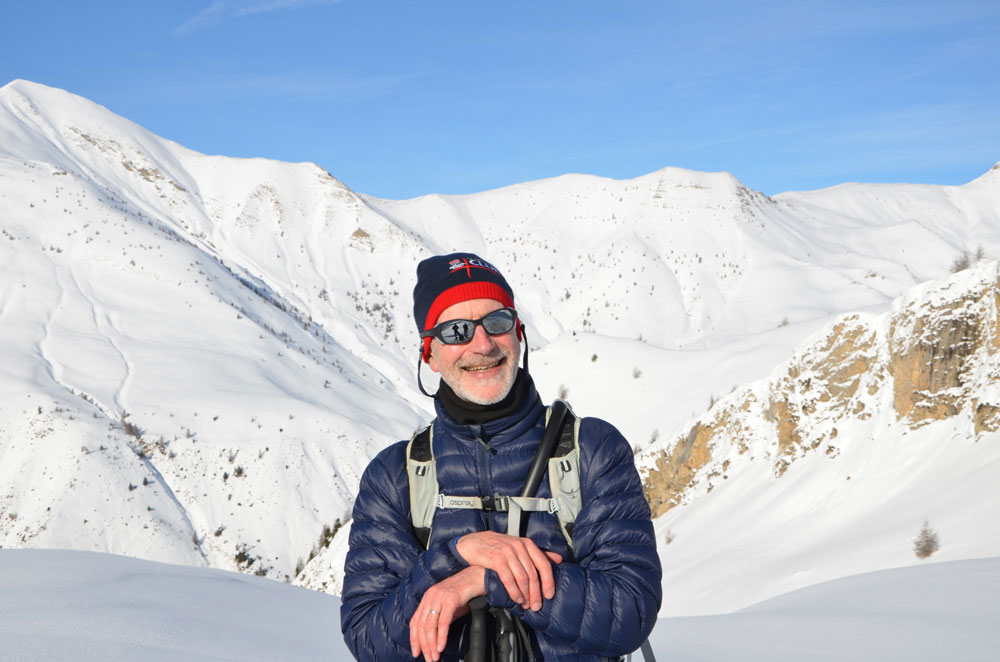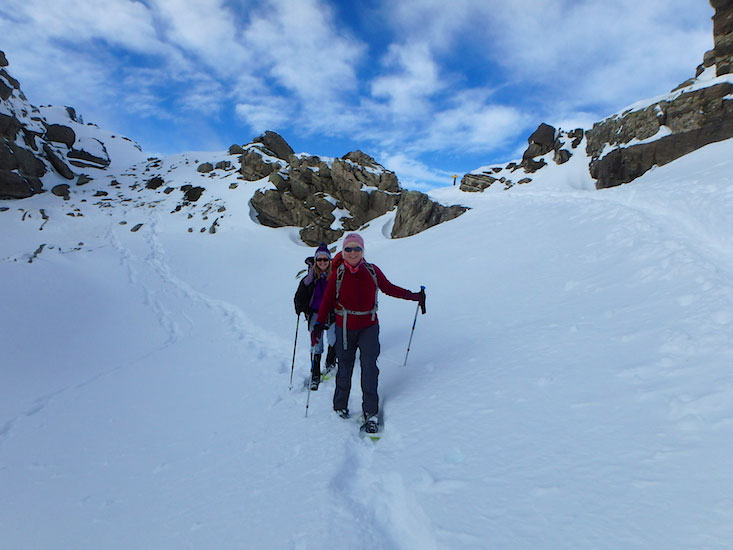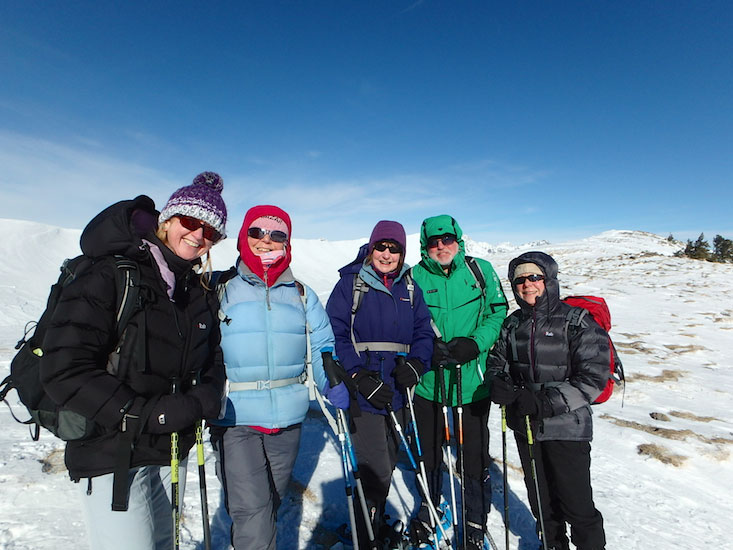Ultimate Guide to Hut-to-Hut Snowshoeing: Essential Kit List and Tips for Your Winter Adventure
There’s something special about moving quietly through the Alps on snowshoes: the gentle crunch of
Read MorePosted 16-06-2025 by Sally Guillaume
“Will I be fit enough to enjoy snowshoeing in the Alps?” This is one of the most common questions people ask us when enquiring about our snowshoeing holidays — and it’s completely natural to wonder.
Even experienced hikers can feel unsure about tackling snowshoeing for the first time. The winter conditions, the snow, and the altitude can feel like unknowns — but with the right mindset and a little preparation, they’re all part of what makes it so special.
In fact, many of the people who join our snowshoeing trips are in their 50s and 60s. They’re active, curious, and love the outdoors. And more often than not, they finish the week saying they wish they’d discovered it sooner.
If the idea of walking through silent forests and across snowy valleys appeals to you, you’re probably already a great fit. A bit of light fitness preparation beforehand can give you extra confidence — and help you enjoy every moment to the fullest.
So if you're thinking about a snowshoeing adventure this winter, here are some simple tips to help you feel strong, ready, and excited for the journey ahead.
.jpg)
First things first, it is always advisable to consult a doctor before making any radical changes to your routine.
Don’t leave everything to the last minute. As we get older our bodies need longer to adjust so break yourself in gently and integrate any lifestyle changes gradually.
A good rule of thumb is to do little and often rather than big exercise sessions once in a while and just gradually add more in. This way you will probably not even notice but your body will!
Snowshoeing is similar to walking in the mountains so there will be some uphill sections that can test your cardio fitness and stamina. There may also be deep snow, which means having to lift your knees up each step. It is good to be with a guide to make tracks for you if there is a lot of deep snow!
Any opportunity to train yourself walking is going to be beneficial but you can also ‘cheat’ to get results without having to put hours and hours of walks in!
We have all heard the government advice about 150 minutes of aerobic activity a week with at least 30 minute sessions at a time.

Current research is fine tuning this with advice on intensity and resistance too with short bursts of more intensive activity proving to have much longer lasting benefits.
If you already walk or go to the gym then try introducing some cardio challenges to your routine, like walking as fast as you can up a hill or increasing the running machine speed and get up to a sprint for 15 seconds. Do this regularly and you will very quickly see an improvement in cardio stamina and fitness without adding any extra hours to your schedule.
If you can’t get to a gym or out for a walk as regularly as you would like then do things like run up the stairs every so often or challenge yourself to mop the kitchen or clean the bathroom in the quickest time possible.
An added bonus is that 45 minutes of targeted exercise a week also boosts brain power in over fifties according to a recent article in the Telegraph about a study published in the British Journal of Sports Medicine.

After 50 men’s levels of testosterone start to drop and women are usually in some stage of menopause. These hormonal changes affect how quickly muscle grows and in general it takes longer to build up muscle strength so perseverance and patience are the key.
Legs are going to be the muscles the most tested on a snowshoeing trip so focus on leg strengthening exercises. Squats, lunges and calf raises are easy exercises to do at home or at the gym but if, like me, you are not disciplined enough to do these by yourself then join a class. Before winter, many gyms offer a ski fit class which will focus on the same muscles and aquagym is especially good for resistance training, whilst also being gentle on the joints.
Including hills on your walks and exaggerating your walking movements by lifting your knees up or kicking your bottom are also good for strengthening those leg muscles.
Do a little test and see if you can stand on one foot for a full minute. If you are over fifty and can’t you are not alone! Loss of balance, it turns out, is not just a problem for the old, it starts declining in midlife according to a recent study.
.jpg)
Balance is very important when walking or snowshoeing in the mountains. You really do not want to fall in rocky steep mountain environments a helicopter ride away from a hospital.
Whilst balance is complicated it is also quite easy to improve.
Practice standing on one foot. You can do this when standing in a queue or brushing your teeth. See how long you can do it for and challenge yourself to get better. As you get better try lifting your free leg higher and putting it to the side, behind or in front.
You can practice getting in and out of a chair without using your hands or try heel to toe walking as if you are on a balance bar.
If you have access to yoga, tai chi or pilates classes, these are also very good at improving balance.
The cold is one of the worries that many people ask us about. How cold is it and how do you prepare for the cold?
How cold it is, is increasingly difficult to predict. It can get as freezing as the -20s in the shade or on a windy day and as pleasantly warm as the +20s in the afternoon sun. The wind and altitude will also have an effect on how the elements affect your body.
The cold in the Southern French Alps where we run the majority of our snowshoeing trips is a very dry cold so it doesn’t get into your bones in the same way as a damp cold. However the dryness can make your skin and lips dry so bring a good ‘cold cream’ moisturizer and lipsalve with sunscreen.

The best way to prepare for the weather in the Alps is to get the right equipment and to feel comfortable and confident in it. Layers are the key with materials that wick away sweat. It can get quite warm, even on a cold day, snowshoeing up hill so you will want to be able to strip down to a thinnish thermal layer and leggings / trousers and have enough room in your rucksack for your layers which should include a thin fleece, a thick fleece, a lightweight duvet jacket (ideal) and a set of waterproofs.
A variety of thicknesses for hats and neck warmers are good too as you can very easily regulate your temperature through your head and neck! Similarly a few different thicknesses of gloves including a fleecey pair with some grip and warm mittens for very cold days. Spare pairs of gloves are also good for if they get wet – nothing worse than having to put wet gloves back on!
Have a look at our snowshoeing kit list and read this article about what to wear for snowshoeing for more detailed information.
You don't have to be super fit to have a fun and memorable snowshoeing holiday, but some preparation will give you the confidence and positive attitude that will make a difference and help you to get the most out of your snowshoeing adventure.
One thing is sure - after a week away snowshoeing in the Alps you will come back feeling revived, refreshed and ready to take on the world!
If you are ready to embark on planning a snowshoeing holiday, then why not give us a call on 0345 009 8501 or email us at [email protected] for some suggestions and ideas.
There’s something special about moving quietly through the Alps on snowshoes: the gentle crunch of
Read MoreEvery summer, the southern French Alps region offers a rare and exhilarating opportunity for cyclist
Read MoreThe higher you go, the better the view - right? It is true that the hours of sweat put in to get to
Read MoreCross-country skiing is often overlooked in favour of other winter sports, but it stands out as one
Read More
0 comments
Submit a comment